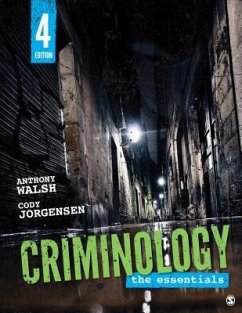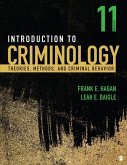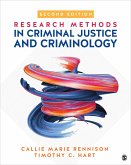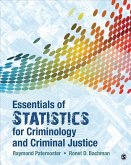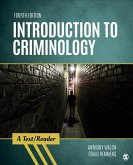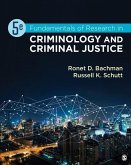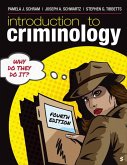- Broschiertes Buch
- Merkliste
- Auf die Merkliste
- Bewerten Bewerten
- Teilen
- Produkt teilen
- Produkterinnerung
- Produkterinnerung
Anthony Walsh and Cody Jorgensen's Criminology: The Essentials introduces students to major theoretical perspectives and topics in a concise, easy-to-read format. This straightforward overview of key subject areas in criminology thoroughly covers the most up-to-date advances in theory and research while challenging students to consider the applications of these theories and their policy implications.
Andere Kunden interessierten sich auch für
![Introduction to Criminology Introduction to Criminology]() Frank E HaganIntroduction to Criminology199,99 €
Frank E HaganIntroduction to Criminology199,99 €![Research Methods in Criminal Justice and Criminology Research Methods in Criminal Justice and Criminology]() Callie Marie RennisonResearch Methods in Criminal Justice and Criminology232,99 €
Callie Marie RennisonResearch Methods in Criminal Justice and Criminology232,99 €![Essentials of Statistics for Criminology and Criminal Justice Essentials of Statistics for Criminology and Criminal Justice]() Raymond PaternosterEssentials of Statistics for Criminology and Criminal Justice195,99 €
Raymond PaternosterEssentials of Statistics for Criminology and Criminal Justice195,99 €![Introduction to Criminology Introduction to Criminology]() Anthony WalshIntroduction to Criminology199,99 €
Anthony WalshIntroduction to Criminology199,99 €![Criminology Criminology]() Anthony WalshCriminology198,99 €
Anthony WalshCriminology198,99 €![Fundamentals of Research in Criminology and Criminal Justice Fundamentals of Research in Criminology and Criminal Justice]() Ronet D BachmanFundamentals of Research in Criminology and Criminal Justice199,99 €
Ronet D BachmanFundamentals of Research in Criminology and Criminal Justice199,99 €![Introduction to Criminology Introduction to Criminology]() Pamela J SchramIntroduction to Criminology157,99 €
Pamela J SchramIntroduction to Criminology157,99 €-
-
-
Anthony Walsh and Cody Jorgensen's Criminology: The Essentials introduces students to major theoretical perspectives and topics in a concise, easy-to-read format. This straightforward overview of key subject areas in criminology thoroughly covers the most up-to-date advances in theory and research while challenging students to consider the applications of these theories and their policy implications.
Hinweis: Dieser Artikel kann nur an eine deutsche Lieferadresse ausgeliefert werden.
Hinweis: Dieser Artikel kann nur an eine deutsche Lieferadresse ausgeliefert werden.
Produktdetails
- Produktdetails
- Verlag: Sage Publications
- 4th edition
- Seitenzahl: 392
- Erscheinungstermin: 24. Januar 2020
- Englisch
- Abmessung: 275mm x 212mm x 15mm
- Gewicht: 846g
- ISBN-13: 9781544375373
- ISBN-10: 1544375379
- Artikelnr.: 58293389
- Herstellerkennzeichnung
- Libri GmbH
- Europaallee 1
- 36244 Bad Hersfeld
- gpsr@libri.de
- Verlag: Sage Publications
- 4th edition
- Seitenzahl: 392
- Erscheinungstermin: 24. Januar 2020
- Englisch
- Abmessung: 275mm x 212mm x 15mm
- Gewicht: 846g
- ISBN-13: 9781544375373
- ISBN-10: 1544375379
- Artikelnr.: 58293389
- Herstellerkennzeichnung
- Libri GmbH
- Europaallee 1
- 36244 Bad Hersfeld
- gpsr@libri.de
Anthony Walsh, is a professor of criminology at Boise State University. He received his PhD from Bowling Green State University at the ripe old age of 43. He has field experience in law enforcement and corrections and is the author of more than 150 journal articles and book chapters and 41 books, including Biology and Criminology; Feminist Criminology Through a Biosocial Lens; Law, Justice, and Society (with Hemmens); Correctional Assessment, Casework, and Counseling (with Stohr); The Neurobiology of Criminal Behavior: Gene-Brain-Culture Interaction (with Bolen, Ashgate); Corrections: The Essentials (with Stohr); The Science Wars: The Politics of Gender and Race; Criminological Theory: Assessing Philosophical Assumptions; Biosociology: Bridging the Biology-Sociology Divide; Criminology: The Essentials (with Jorgensen); and Answering Atheists: How Science Points to God and the Benefits of Christianity. His interests include biosocial criminology, statistics, and criminal justice assessment and counseling.
Preface
Foreword
Acknowledgments
Chapter 1: Criminology, Crime, And Criminal Law
What Is Criminology?
What Is Crime?
Crime as a Moving Target
Crime as a Subcategory of Social Harms
Beyond Social Construction: The Stationary Core Crimes
Box 1.1 Mala in Se or Mala Prohibita? The Cannibal and His Willing Victim
Victimful and Victimless Crimes
The Felony-Misdemeanor Distinction
Criminality
The Legal Making of a Criminal
An Excursion Through the U.S. Criminal Justice System
The Role of Theory in Criminology
The Classical School
Chapter 2: Measuring Crime And Criminal Behavior
Categorizing and Measuring Crime and Criminal Behavior
The Dark Figure of Crime Revisited
Box 2.1 The Crime Problem or the Criminality Problem?
The Financial Cost of Crime
Interpreting Crime Trends
Box 2.2 Is the United States Hard or Soft on Crime?
Summary
Exercises and Discussion Questions
Key Words
Chapter 3: The Early Schools Of Criminology And Modern Counterparts
The Classical Scholars
The Rise of Positivism
Box 3.1 Lombrosoism Before and After Lombroso
Neoclassicism: Rational Choice Theory
Connecting Criminological Theory and Social Policy
Summary
Exercises and Discussion Questions
Key Words
Chapter 4: Social Structural Theories
The Social Structural Tradition
Sociological Positivism
Box 4.1 People Versus Places: Do Neighborhoods Matter?
Subcultural Theories
Box 4.2 Does Poverty Cause Crime, or Does Crime Cause Poverty?
Youth Gangs
Evaluation of Social Structural Theories
Policy and Prevention: Implications of Social Structural Theories
Summary
Exercises and Discussion Questions
Key Words
Chapter 5: Social Process Theories
The Social Process Tradition
Social Control Theories
Box 5.1 Self-Esteem and Crime
Evaluation of Social Process Theories
Policy and Prevention: Implications of Social Process Theories
Summary
Exercises and Discussion Questions
Key Words
Chapter 6: Critical Theories: Marxist, Conflict, And Feminist
The Conflict Perspective of Society
Conflict Theory: Max Weber, Power and Conflict
Box 6.1 The Supreme Court and Class Conflict
Feminist Criminology
Evaluation of Critical Theories
Policy and Prevention: Implications of Critical Theories
Summary
Exercises and Discussion Questions
Key Words
Chapter 7: Psychosocial Theories: Individual Traits And Criminal Behavior
Modern Psychology and Intelligence
Box 7.1 The Impact of High and Low IQ on Life Outcomes
The Role of Temperament
Modern Psychosocial Theories
The Antisocial Personalities
Evaluation of the Psychosocial Perspective
Policy and Prevention: Implications of Psychosocial Theories
Summary
Exercises and Discussion Questions
Key Words
Chapter 8: Biosocial Approaches
Behavior Genetics
Box 8.1 Gene-Environment Interaction: MAO, Abuse/Neglect, and Crime
Evolutionary Psychology
The Neurohormonal Sciences
Evaluation of the Biosocial Perspective
Policy and Prevention: Implications of Biosocial Theories
Summary
Exercises and Discussion Questions
Key Words
Chapter 9: Developmental Theories: From Delinquency To Crime To Desistance
Juvenile Delinquency
Box 9.1 What Role Do Genes Play in Juvenile Delinquency?
Major Developmental Theories
Evaluation of Development Theories
Box 9.2 Summary of Key Points, Strengths, and Differences of Developmental
Theories
Policy and Prevention: Implications of Development Theories
Summary
Exercises and Discussion Questions
Key Words
Chapter 10: Altered Minds And Crime: Alcohol, Drugs, And Mental Illness
The Scope of the Alcohol/Crime Problem
Illegal Drugs and Crime
Box 10.1 Treatment Modalities for Substance Abuse in the Criminal Justice
System
Box 10.2 Portrait of a Schizophrenic
Summary
Exercises and Discussion Questions
Key Terms
Chapter 11: Crimes of Violence
Murder
Rape and Rapists
Box 11.1 Characteristics of Rapists
Robbery and Robbers
Aggravated Assault
Explaining Violence Sociologically: The Subculture of Violence Thesis
Evolutionary Considerations:What Is Violence For?
Box 11.2 Evolutionary Considerations of Inequality and Violence
Summary
Exercises and Discussion Questions
Key Terms
Chapter 12: Serial, Mass, and Spree Murder
What Is Multiple Murder?
Box 12.1 Recent Long-Term Serial Killers: The Green River and BTK Cases
Theories About the Causes of Serial Killing
Law Enforcement's Response to Serial Killing
Box 12.2 The First Serial Killer Profile: Jack the Ripper
Summary
Exercises and Discussion Questions
Key Terms
Chapter 13: Terrorism and Terrorists
Terrorism Defined
Why Terrorism?
Is There a Difference Between Terrorists and Freedom Fighters?
The Extent of Terrorism
Terrorism and Common Crime
Some Important Terrorist Groups
Box 13.1 The Irish Republican Army: A Decommissioned Group?
Terrorism in the United States
Theories About the Causes of Terrorism
Is There a Terrorist Personality?
Becoming a Terrorist
Law Enforcement Response and Government Policy
Summary
Exercises and Discussion Questions
Key Terms
Chapter 14: Property And Public Order Crimes
Larceny-Theft
Burglary
Motor Vehicle Theft
Box 14.1 Carjacking: MV Theft With an Attitude
Arson
Crimes of Guile and Deceit
Cybercrime: Oh What a Tangled World Wide Web We Weave
Box 14.2 Phishing: "If It's Too Good to Be True . . ."
Public-Order Offenses
Summary
Exercises and Discussion Questions
Key Terms
Chapter 15: White-Collar And Organized Crime
The Concept of White-Collar Crime
Corporate Crime
Box 15.1 Crimes of America's Rich and Famous in History
Organized Crime
Box 15.2 The Mafia: The Sicilian Origins and History
Theories About the Causes of Organized Crime
Law Enforcement's Response to Organized Crime
Summary
Exercises and Discussion Questions
Key Terms
Chapter 16: Victimology: Exploring The Experience Of Victimization
The Emergence of Victimology
Who Gets Victimized?
Victimization in the Workplace and School
Child Molestation:Who Gets Victimized?
Victimization Theories
The Consequences of Victimization
Box 16.1 A Case of Cybervictimization and Its Consequences
Victimization and the Criminal Justice System
Box 16.2 Victims' Opinions of the Importance of Victims' Rights
Victim-Offender Reconciliation Programs (VORPS)
Summary
Exercises and Discussion Questions
Key Words
Glossary
Author Index
Subject Index
About the Authors
Foreword
Acknowledgments
Chapter 1: Criminology, Crime, And Criminal Law
What Is Criminology?
What Is Crime?
Crime as a Moving Target
Crime as a Subcategory of Social Harms
Beyond Social Construction: The Stationary Core Crimes
Box 1.1 Mala in Se or Mala Prohibita? The Cannibal and His Willing Victim
Victimful and Victimless Crimes
The Felony-Misdemeanor Distinction
Criminality
The Legal Making of a Criminal
An Excursion Through the U.S. Criminal Justice System
The Role of Theory in Criminology
The Classical School
Chapter 2: Measuring Crime And Criminal Behavior
Categorizing and Measuring Crime and Criminal Behavior
The Dark Figure of Crime Revisited
Box 2.1 The Crime Problem or the Criminality Problem?
The Financial Cost of Crime
Interpreting Crime Trends
Box 2.2 Is the United States Hard or Soft on Crime?
Summary
Exercises and Discussion Questions
Key Words
Chapter 3: The Early Schools Of Criminology And Modern Counterparts
The Classical Scholars
The Rise of Positivism
Box 3.1 Lombrosoism Before and After Lombroso
Neoclassicism: Rational Choice Theory
Connecting Criminological Theory and Social Policy
Summary
Exercises and Discussion Questions
Key Words
Chapter 4: Social Structural Theories
The Social Structural Tradition
Sociological Positivism
Box 4.1 People Versus Places: Do Neighborhoods Matter?
Subcultural Theories
Box 4.2 Does Poverty Cause Crime, or Does Crime Cause Poverty?
Youth Gangs
Evaluation of Social Structural Theories
Policy and Prevention: Implications of Social Structural Theories
Summary
Exercises and Discussion Questions
Key Words
Chapter 5: Social Process Theories
The Social Process Tradition
Social Control Theories
Box 5.1 Self-Esteem and Crime
Evaluation of Social Process Theories
Policy and Prevention: Implications of Social Process Theories
Summary
Exercises and Discussion Questions
Key Words
Chapter 6: Critical Theories: Marxist, Conflict, And Feminist
The Conflict Perspective of Society
Conflict Theory: Max Weber, Power and Conflict
Box 6.1 The Supreme Court and Class Conflict
Feminist Criminology
Evaluation of Critical Theories
Policy and Prevention: Implications of Critical Theories
Summary
Exercises and Discussion Questions
Key Words
Chapter 7: Psychosocial Theories: Individual Traits And Criminal Behavior
Modern Psychology and Intelligence
Box 7.1 The Impact of High and Low IQ on Life Outcomes
The Role of Temperament
Modern Psychosocial Theories
The Antisocial Personalities
Evaluation of the Psychosocial Perspective
Policy and Prevention: Implications of Psychosocial Theories
Summary
Exercises and Discussion Questions
Key Words
Chapter 8: Biosocial Approaches
Behavior Genetics
Box 8.1 Gene-Environment Interaction: MAO, Abuse/Neglect, and Crime
Evolutionary Psychology
The Neurohormonal Sciences
Evaluation of the Biosocial Perspective
Policy and Prevention: Implications of Biosocial Theories
Summary
Exercises and Discussion Questions
Key Words
Chapter 9: Developmental Theories: From Delinquency To Crime To Desistance
Juvenile Delinquency
Box 9.1 What Role Do Genes Play in Juvenile Delinquency?
Major Developmental Theories
Evaluation of Development Theories
Box 9.2 Summary of Key Points, Strengths, and Differences of Developmental
Theories
Policy and Prevention: Implications of Development Theories
Summary
Exercises and Discussion Questions
Key Words
Chapter 10: Altered Minds And Crime: Alcohol, Drugs, And Mental Illness
The Scope of the Alcohol/Crime Problem
Illegal Drugs and Crime
Box 10.1 Treatment Modalities for Substance Abuse in the Criminal Justice
System
Box 10.2 Portrait of a Schizophrenic
Summary
Exercises and Discussion Questions
Key Terms
Chapter 11: Crimes of Violence
Murder
Rape and Rapists
Box 11.1 Characteristics of Rapists
Robbery and Robbers
Aggravated Assault
Explaining Violence Sociologically: The Subculture of Violence Thesis
Evolutionary Considerations:What Is Violence For?
Box 11.2 Evolutionary Considerations of Inequality and Violence
Summary
Exercises and Discussion Questions
Key Terms
Chapter 12: Serial, Mass, and Spree Murder
What Is Multiple Murder?
Box 12.1 Recent Long-Term Serial Killers: The Green River and BTK Cases
Theories About the Causes of Serial Killing
Law Enforcement's Response to Serial Killing
Box 12.2 The First Serial Killer Profile: Jack the Ripper
Summary
Exercises and Discussion Questions
Key Terms
Chapter 13: Terrorism and Terrorists
Terrorism Defined
Why Terrorism?
Is There a Difference Between Terrorists and Freedom Fighters?
The Extent of Terrorism
Terrorism and Common Crime
Some Important Terrorist Groups
Box 13.1 The Irish Republican Army: A Decommissioned Group?
Terrorism in the United States
Theories About the Causes of Terrorism
Is There a Terrorist Personality?
Becoming a Terrorist
Law Enforcement Response and Government Policy
Summary
Exercises and Discussion Questions
Key Terms
Chapter 14: Property And Public Order Crimes
Larceny-Theft
Burglary
Motor Vehicle Theft
Box 14.1 Carjacking: MV Theft With an Attitude
Arson
Crimes of Guile and Deceit
Cybercrime: Oh What a Tangled World Wide Web We Weave
Box 14.2 Phishing: "If It's Too Good to Be True . . ."
Public-Order Offenses
Summary
Exercises and Discussion Questions
Key Terms
Chapter 15: White-Collar And Organized Crime
The Concept of White-Collar Crime
Corporate Crime
Box 15.1 Crimes of America's Rich and Famous in History
Organized Crime
Box 15.2 The Mafia: The Sicilian Origins and History
Theories About the Causes of Organized Crime
Law Enforcement's Response to Organized Crime
Summary
Exercises and Discussion Questions
Key Terms
Chapter 16: Victimology: Exploring The Experience Of Victimization
The Emergence of Victimology
Who Gets Victimized?
Victimization in the Workplace and School
Child Molestation:Who Gets Victimized?
Victimization Theories
The Consequences of Victimization
Box 16.1 A Case of Cybervictimization and Its Consequences
Victimization and the Criminal Justice System
Box 16.2 Victims' Opinions of the Importance of Victims' Rights
Victim-Offender Reconciliation Programs (VORPS)
Summary
Exercises and Discussion Questions
Key Words
Glossary
Author Index
Subject Index
About the Authors
Preface
Foreword
Acknowledgments
Chapter 1: Criminology, Crime, And Criminal Law
What Is Criminology?
What Is Crime?
Crime as a Moving Target
Crime as a Subcategory of Social Harms
Beyond Social Construction: The Stationary Core Crimes
Box 1.1 Mala in Se or Mala Prohibita? The Cannibal and His Willing Victim
Victimful and Victimless Crimes
The Felony-Misdemeanor Distinction
Criminality
The Legal Making of a Criminal
An Excursion Through the U.S. Criminal Justice System
The Role of Theory in Criminology
The Classical School
Chapter 2: Measuring Crime And Criminal Behavior
Categorizing and Measuring Crime and Criminal Behavior
The Dark Figure of Crime Revisited
Box 2.1 The Crime Problem or the Criminality Problem?
The Financial Cost of Crime
Interpreting Crime Trends
Box 2.2 Is the United States Hard or Soft on Crime?
Summary
Exercises and Discussion Questions
Key Words
Chapter 3: The Early Schools Of Criminology And Modern Counterparts
The Classical Scholars
The Rise of Positivism
Box 3.1 Lombrosoism Before and After Lombroso
Neoclassicism: Rational Choice Theory
Connecting Criminological Theory and Social Policy
Summary
Exercises and Discussion Questions
Key Words
Chapter 4: Social Structural Theories
The Social Structural Tradition
Sociological Positivism
Box 4.1 People Versus Places: Do Neighborhoods Matter?
Subcultural Theories
Box 4.2 Does Poverty Cause Crime, or Does Crime Cause Poverty?
Youth Gangs
Evaluation of Social Structural Theories
Policy and Prevention: Implications of Social Structural Theories
Summary
Exercises and Discussion Questions
Key Words
Chapter 5: Social Process Theories
The Social Process Tradition
Social Control Theories
Box 5.1 Self-Esteem and Crime
Evaluation of Social Process Theories
Policy and Prevention: Implications of Social Process Theories
Summary
Exercises and Discussion Questions
Key Words
Chapter 6: Critical Theories: Marxist, Conflict, And Feminist
The Conflict Perspective of Society
Conflict Theory: Max Weber, Power and Conflict
Box 6.1 The Supreme Court and Class Conflict
Feminist Criminology
Evaluation of Critical Theories
Policy and Prevention: Implications of Critical Theories
Summary
Exercises and Discussion Questions
Key Words
Chapter 7: Psychosocial Theories: Individual Traits And Criminal Behavior
Modern Psychology and Intelligence
Box 7.1 The Impact of High and Low IQ on Life Outcomes
The Role of Temperament
Modern Psychosocial Theories
The Antisocial Personalities
Evaluation of the Psychosocial Perspective
Policy and Prevention: Implications of Psychosocial Theories
Summary
Exercises and Discussion Questions
Key Words
Chapter 8: Biosocial Approaches
Behavior Genetics
Box 8.1 Gene-Environment Interaction: MAO, Abuse/Neglect, and Crime
Evolutionary Psychology
The Neurohormonal Sciences
Evaluation of the Biosocial Perspective
Policy and Prevention: Implications of Biosocial Theories
Summary
Exercises and Discussion Questions
Key Words
Chapter 9: Developmental Theories: From Delinquency To Crime To Desistance
Juvenile Delinquency
Box 9.1 What Role Do Genes Play in Juvenile Delinquency?
Major Developmental Theories
Evaluation of Development Theories
Box 9.2 Summary of Key Points, Strengths, and Differences of Developmental
Theories
Policy and Prevention: Implications of Development Theories
Summary
Exercises and Discussion Questions
Key Words
Chapter 10: Altered Minds And Crime: Alcohol, Drugs, And Mental Illness
The Scope of the Alcohol/Crime Problem
Illegal Drugs and Crime
Box 10.1 Treatment Modalities for Substance Abuse in the Criminal Justice
System
Box 10.2 Portrait of a Schizophrenic
Summary
Exercises and Discussion Questions
Key Terms
Chapter 11: Crimes of Violence
Murder
Rape and Rapists
Box 11.1 Characteristics of Rapists
Robbery and Robbers
Aggravated Assault
Explaining Violence Sociologically: The Subculture of Violence Thesis
Evolutionary Considerations:What Is Violence For?
Box 11.2 Evolutionary Considerations of Inequality and Violence
Summary
Exercises and Discussion Questions
Key Terms
Chapter 12: Serial, Mass, and Spree Murder
What Is Multiple Murder?
Box 12.1 Recent Long-Term Serial Killers: The Green River and BTK Cases
Theories About the Causes of Serial Killing
Law Enforcement's Response to Serial Killing
Box 12.2 The First Serial Killer Profile: Jack the Ripper
Summary
Exercises and Discussion Questions
Key Terms
Chapter 13: Terrorism and Terrorists
Terrorism Defined
Why Terrorism?
Is There a Difference Between Terrorists and Freedom Fighters?
The Extent of Terrorism
Terrorism and Common Crime
Some Important Terrorist Groups
Box 13.1 The Irish Republican Army: A Decommissioned Group?
Terrorism in the United States
Theories About the Causes of Terrorism
Is There a Terrorist Personality?
Becoming a Terrorist
Law Enforcement Response and Government Policy
Summary
Exercises and Discussion Questions
Key Terms
Chapter 14: Property And Public Order Crimes
Larceny-Theft
Burglary
Motor Vehicle Theft
Box 14.1 Carjacking: MV Theft With an Attitude
Arson
Crimes of Guile and Deceit
Cybercrime: Oh What a Tangled World Wide Web We Weave
Box 14.2 Phishing: "If It's Too Good to Be True . . ."
Public-Order Offenses
Summary
Exercises and Discussion Questions
Key Terms
Chapter 15: White-Collar And Organized Crime
The Concept of White-Collar Crime
Corporate Crime
Box 15.1 Crimes of America's Rich and Famous in History
Organized Crime
Box 15.2 The Mafia: The Sicilian Origins and History
Theories About the Causes of Organized Crime
Law Enforcement's Response to Organized Crime
Summary
Exercises and Discussion Questions
Key Terms
Chapter 16: Victimology: Exploring The Experience Of Victimization
The Emergence of Victimology
Who Gets Victimized?
Victimization in the Workplace and School
Child Molestation:Who Gets Victimized?
Victimization Theories
The Consequences of Victimization
Box 16.1 A Case of Cybervictimization and Its Consequences
Victimization and the Criminal Justice System
Box 16.2 Victims' Opinions of the Importance of Victims' Rights
Victim-Offender Reconciliation Programs (VORPS)
Summary
Exercises and Discussion Questions
Key Words
Glossary
Author Index
Subject Index
About the Authors
Foreword
Acknowledgments
Chapter 1: Criminology, Crime, And Criminal Law
What Is Criminology?
What Is Crime?
Crime as a Moving Target
Crime as a Subcategory of Social Harms
Beyond Social Construction: The Stationary Core Crimes
Box 1.1 Mala in Se or Mala Prohibita? The Cannibal and His Willing Victim
Victimful and Victimless Crimes
The Felony-Misdemeanor Distinction
Criminality
The Legal Making of a Criminal
An Excursion Through the U.S. Criminal Justice System
The Role of Theory in Criminology
The Classical School
Chapter 2: Measuring Crime And Criminal Behavior
Categorizing and Measuring Crime and Criminal Behavior
The Dark Figure of Crime Revisited
Box 2.1 The Crime Problem or the Criminality Problem?
The Financial Cost of Crime
Interpreting Crime Trends
Box 2.2 Is the United States Hard or Soft on Crime?
Summary
Exercises and Discussion Questions
Key Words
Chapter 3: The Early Schools Of Criminology And Modern Counterparts
The Classical Scholars
The Rise of Positivism
Box 3.1 Lombrosoism Before and After Lombroso
Neoclassicism: Rational Choice Theory
Connecting Criminological Theory and Social Policy
Summary
Exercises and Discussion Questions
Key Words
Chapter 4: Social Structural Theories
The Social Structural Tradition
Sociological Positivism
Box 4.1 People Versus Places: Do Neighborhoods Matter?
Subcultural Theories
Box 4.2 Does Poverty Cause Crime, or Does Crime Cause Poverty?
Youth Gangs
Evaluation of Social Structural Theories
Policy and Prevention: Implications of Social Structural Theories
Summary
Exercises and Discussion Questions
Key Words
Chapter 5: Social Process Theories
The Social Process Tradition
Social Control Theories
Box 5.1 Self-Esteem and Crime
Evaluation of Social Process Theories
Policy and Prevention: Implications of Social Process Theories
Summary
Exercises and Discussion Questions
Key Words
Chapter 6: Critical Theories: Marxist, Conflict, And Feminist
The Conflict Perspective of Society
Conflict Theory: Max Weber, Power and Conflict
Box 6.1 The Supreme Court and Class Conflict
Feminist Criminology
Evaluation of Critical Theories
Policy and Prevention: Implications of Critical Theories
Summary
Exercises and Discussion Questions
Key Words
Chapter 7: Psychosocial Theories: Individual Traits And Criminal Behavior
Modern Psychology and Intelligence
Box 7.1 The Impact of High and Low IQ on Life Outcomes
The Role of Temperament
Modern Psychosocial Theories
The Antisocial Personalities
Evaluation of the Psychosocial Perspective
Policy and Prevention: Implications of Psychosocial Theories
Summary
Exercises and Discussion Questions
Key Words
Chapter 8: Biosocial Approaches
Behavior Genetics
Box 8.1 Gene-Environment Interaction: MAO, Abuse/Neglect, and Crime
Evolutionary Psychology
The Neurohormonal Sciences
Evaluation of the Biosocial Perspective
Policy and Prevention: Implications of Biosocial Theories
Summary
Exercises and Discussion Questions
Key Words
Chapter 9: Developmental Theories: From Delinquency To Crime To Desistance
Juvenile Delinquency
Box 9.1 What Role Do Genes Play in Juvenile Delinquency?
Major Developmental Theories
Evaluation of Development Theories
Box 9.2 Summary of Key Points, Strengths, and Differences of Developmental
Theories
Policy and Prevention: Implications of Development Theories
Summary
Exercises and Discussion Questions
Key Words
Chapter 10: Altered Minds And Crime: Alcohol, Drugs, And Mental Illness
The Scope of the Alcohol/Crime Problem
Illegal Drugs and Crime
Box 10.1 Treatment Modalities for Substance Abuse in the Criminal Justice
System
Box 10.2 Portrait of a Schizophrenic
Summary
Exercises and Discussion Questions
Key Terms
Chapter 11: Crimes of Violence
Murder
Rape and Rapists
Box 11.1 Characteristics of Rapists
Robbery and Robbers
Aggravated Assault
Explaining Violence Sociologically: The Subculture of Violence Thesis
Evolutionary Considerations:What Is Violence For?
Box 11.2 Evolutionary Considerations of Inequality and Violence
Summary
Exercises and Discussion Questions
Key Terms
Chapter 12: Serial, Mass, and Spree Murder
What Is Multiple Murder?
Box 12.1 Recent Long-Term Serial Killers: The Green River and BTK Cases
Theories About the Causes of Serial Killing
Law Enforcement's Response to Serial Killing
Box 12.2 The First Serial Killer Profile: Jack the Ripper
Summary
Exercises and Discussion Questions
Key Terms
Chapter 13: Terrorism and Terrorists
Terrorism Defined
Why Terrorism?
Is There a Difference Between Terrorists and Freedom Fighters?
The Extent of Terrorism
Terrorism and Common Crime
Some Important Terrorist Groups
Box 13.1 The Irish Republican Army: A Decommissioned Group?
Terrorism in the United States
Theories About the Causes of Terrorism
Is There a Terrorist Personality?
Becoming a Terrorist
Law Enforcement Response and Government Policy
Summary
Exercises and Discussion Questions
Key Terms
Chapter 14: Property And Public Order Crimes
Larceny-Theft
Burglary
Motor Vehicle Theft
Box 14.1 Carjacking: MV Theft With an Attitude
Arson
Crimes of Guile and Deceit
Cybercrime: Oh What a Tangled World Wide Web We Weave
Box 14.2 Phishing: "If It's Too Good to Be True . . ."
Public-Order Offenses
Summary
Exercises and Discussion Questions
Key Terms
Chapter 15: White-Collar And Organized Crime
The Concept of White-Collar Crime
Corporate Crime
Box 15.1 Crimes of America's Rich and Famous in History
Organized Crime
Box 15.2 The Mafia: The Sicilian Origins and History
Theories About the Causes of Organized Crime
Law Enforcement's Response to Organized Crime
Summary
Exercises and Discussion Questions
Key Terms
Chapter 16: Victimology: Exploring The Experience Of Victimization
The Emergence of Victimology
Who Gets Victimized?
Victimization in the Workplace and School
Child Molestation:Who Gets Victimized?
Victimization Theories
The Consequences of Victimization
Box 16.1 A Case of Cybervictimization and Its Consequences
Victimization and the Criminal Justice System
Box 16.2 Victims' Opinions of the Importance of Victims' Rights
Victim-Offender Reconciliation Programs (VORPS)
Summary
Exercises and Discussion Questions
Key Words
Glossary
Author Index
Subject Index
About the Authors

